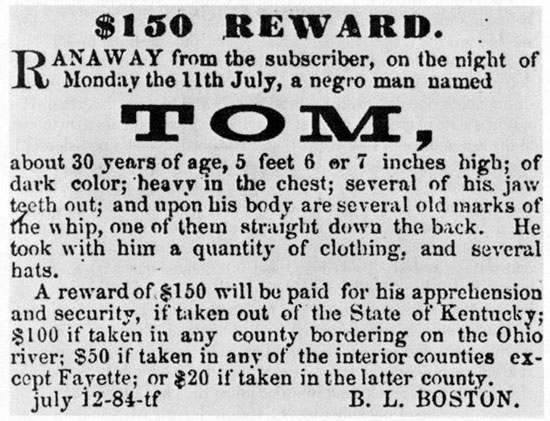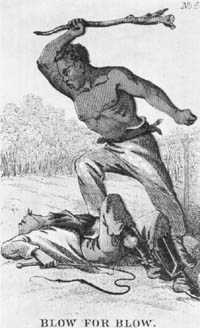William Parker and the Resistance at Christiana, September 11, 1851
Share
Explore Our Galleries
Breaking News!
Today's news and culture by Black and other reporters in the Black and mainstream media.
Ways to Support ABHM?
Adapted from Wikipedia
On this day we remember the Christiana Resistance, the first slave revolt against the Fugitive Slave Laws.
William Parker, an escaped former slave from Roedown Plantation in Maryland, was an anti-slavery activist and a principal character in the events of September 11, 1851 in Christiana, Pennsylvania. The Christiana “Incident” resulted in the death of a Maryland slaveowner. It brought the attention of the country to the perils and challenges of attempting to enforce the Fugitive Slave Law of 1850.
Parker had escaped to Christiana, Pennsylvania, near the Maryland border, where he married and settled. Inspired by the speeches of William Lloyd Garrison and Frederick Douglass, Parker encouraged members from the community to form a mutual protection society. Slave catchers would often come into the area seeking escaped slaves to return to their slaveholders. They were paid handsomely for their services and in many cases would capture freed blacks as well.
Parker and other members of the mutual protection society were well known for using whatever force necessary to prevent the recapture of blacks in the area. They had a great intelligence network to know when slave catchers were about and would readily spring into action to retrieve any captives before they could be taken back across state lines. If the laws of the country would not protect them, their family, friends and neighbors, then they would protect themselves.
One such incident of resistance occurred on September 11, 1851 when a slaveholder from Maryland, Edward Gorsuch, came bearing a warrant to recover his slaves. Gorsuch had information that his slaves were at Parker’s farmhouse. Parker had received intelligence that Gorsuch, a federal marshal and others were on their way to his farmhouse. So when Gorsuch arrived, Parker and his cohorts were prepared. Eliza, Parker’s wife, sounded a horn alerting neighbors that slave catchers were out and that help was needed. Both sides were resolute in their determination to prevail – Parker convinced of the immorality of slavery – Gorsuch confident in the law and his right to own slaves. There are conflicting stories of why and how the shooting started but in the end Gorsuch was dead and his son severely wounded.
U.S. Marines were brought in to stabilize the situation. There was significant pressure from the South to obtain justice for Gorsuch, the slain white slaveowner. Following an extensive search, a group of 38 men (including four white Quakers) were accused of treason for their defiance of the federal order. All the accused were eventually released, signalling a major win in the fight against slavery and strengthening the resolve of anti-slavery forces across the country.
Parker went into hiding that fateful evening. Using the underground railroad he later made his way to Rochester, New York where Frederick Douglass assisted him into Canada. He, his wife, and their three children eventually found their way to a black settlement in Buxton, Ontario where they purchased a 50-acre lot of land and had more children.
Read more about Parker and the Christiana “Incident” here.
Fugitive slave laws were one way to enforce slavery.
Comments Are Welcome
Note: We moderate submissions in order to create a space for meaningful dialogue, a space where museum visitors – adults and youth –– can exchange informed, thoughtful, and relevant comments that add value to our exhibits.
Racial slurs, personal attacks, obscenity, profanity, and SHOUTING do not meet the above standard. Such comments are posted in the exhibit Hateful Speech. Commercial promotions, impersonations, and incoherent comments likewise fail to meet our goals, so will not be posted. Submissions longer than 120 words will be shortened.
See our full Comments Policy here.











Looking for other information after viewing a History Channel show: “Who Do You Think You Are”
Zooey Deschanel episode.
This was very information for me and my family. I’m so happy about with this site and i will use it to teach my children black history that they can’t learn in school.
Am so happy to have followed up on researching more about the Christana Revolt of 1851. I was watching the Zooey Deschanel episode of “Who Do You Think You Are.” Never too late to learn about my African/American history at my 75 years of age.
I am a descendent of William Parker. During my search I have come across a reference to a photograph of William Parker. I am searching for any and all photographs of William Parker or his family. Any help or information would be most appreciated.
Great information. I did read that the free African Americans in the area suffered terribly after this event. I’ve attached an article that speaks briefly of it. Unfortunately I cannot find the original article I read. Thank you for all that you do.
https://explorepahistory.com/hmarker.php?markerId=1-A-109